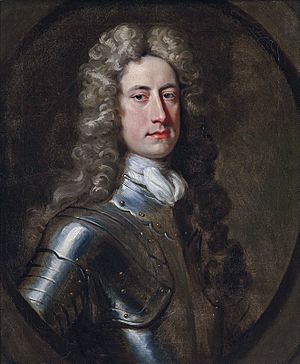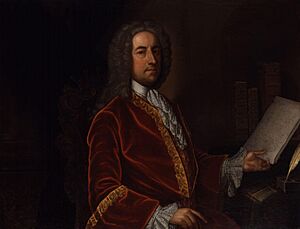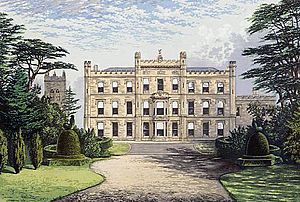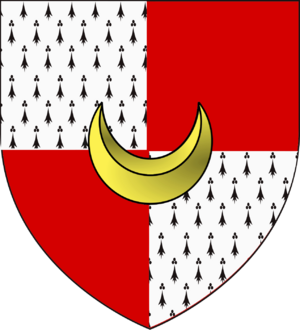William Stanhope, 1st Earl of Harrington facts for kids
Quick facts for kids
The Earl of Harrington
|
|
|---|---|

William Stanhope, 1st Earl of Harrington (Godfrey Kneller, 1646–1723)
|
|
| Secretary of State for the Northern Department | |
| In office 19 June 1730 – 12 February 1742 |
|
| Monarch | George II |
| Prime Minister | Robert Walpole |
| Preceded by | Charles Townshend, 2nd Viscount Townshend |
| Succeeded by | John Carteret, 2nd Earl Granville |
| In office 24 November 1744 – January 1746 |
|
| Monarch | George II |
| Prime Minister | Henry Pelham |
| Preceded by | John Carteret, 2nd Earl Granville |
| Succeeded by | John Carteret, 2nd Earl Granville |
| Lord Lieutenant of Ireland | |
| In office 15 November 1746 – 15 December 1750 |
|
| Monarch | George II |
| Preceded by | The Earl of Chesterfield |
| Succeeded by | The Duke of Dorset |
| Lord President of the Council | |
| In office 13 February 1742 – 3 January 1745 |
|
| Monarch | George II |
| Prime Minister | The Earl of Wilmington Henry Pelham |
| Preceded by | The Earl of Wilmington |
| Succeeded by | The Duke of Dorset |
| Personal details | |
| Born |
William Stanhope
c. 1683 Elvaston, Derbyshire |
| Died | 8 December 1756 London, England. |
| Nationality | British |
| Spouse | Anne Griffith |
| Parents | John Stanhope Dorothy Agard |
| Residence | Elvaston Castle |
William Stanhope, 1st Earl of Harrington (born around 1683, died December 8, 1756) was an important British politician and diplomat. A diplomat is someone who represents their country in other nations, helping to keep peace and good relationships. A statesman is a skilled and respected political leader.
Contents
Who Was William Stanhope?
William Stanhope was born in 1683. His family lived in Elvaston, Derbyshire, England. He was the third son of John Stanhope and Dorothy Agard.
William married Anne Griffiths. Sadly, Anne passed away in 1719 while giving birth to their twin sons. Their sons were William (who later became the 2nd Earl of Harrington) and Thomas.
Stanhope's Early Career
William Stanhope went to school at Eton College. In 1703, he joined the army as a lieutenant. This was during a big war called the War of the Spanish Succession. He served in Spain.
By 1710, he had become a lieutenant-colonel. He missed an important battle in December 1710, the Battle of Brihuega. After the war, his army unit was disbanded in 1712.
A Diplomat and Soldier
Stanhope started working as a diplomat in Spain. This was when another war, the War of the Quadruple Alliance, began in 1719. He joined the French army as a volunteer and helped in the successful Siege of San Sebastian.
When the war ended in 1720, Stanhope became the British ambassador to Spain. An ambassador is the highest-ranking diplomat representing their country. He also became the Colonel of the 13th Light Dragoons, a military regiment. He kept these important roles until the Anglo-Spanish War started in 1727. During this time, he became known as a very skilled diplomat.
Rising in Politics
William Stanhope played a key part in making the Treaty of Seville in 1729. This treaty helped end the war. Because of his success, he was given the title Baron Harrington in January 1730.
Later that same year, he became the Secretary of State for the Northern Department. This was a very important job, like being a foreign minister today. He worked under Robert Walpole, who was a powerful leader at the time.
Even though he sometimes disagreed with Walpole, he kept his job until Walpole left office in 1742. After that, Stanhope became the Lord President of the Council. This is another high-ranking government position. At this time, he was given even higher titles: Earl of Harrington and Viscount Petersham.
Later Years and Legacy
With help from his political friend, the Duke of Newcastle, William Stanhope became Secretary of State again in 1744. However, he resigned in 1746 because he wanted to end the War of the Austrian Succession quickly.
From 1747 to 1751, he served as the Lord Lieutenant of Ireland. This role was like being the King's representative in Ireland. Even though his active fighting career ended in 1720, he continued to receive military promotions. He eventually became a full General in 1747.
William Stanhope passed away in London on December 8, 1756. He was a significant figure in British politics and diplomacy during the 18th century.
Images for kids








